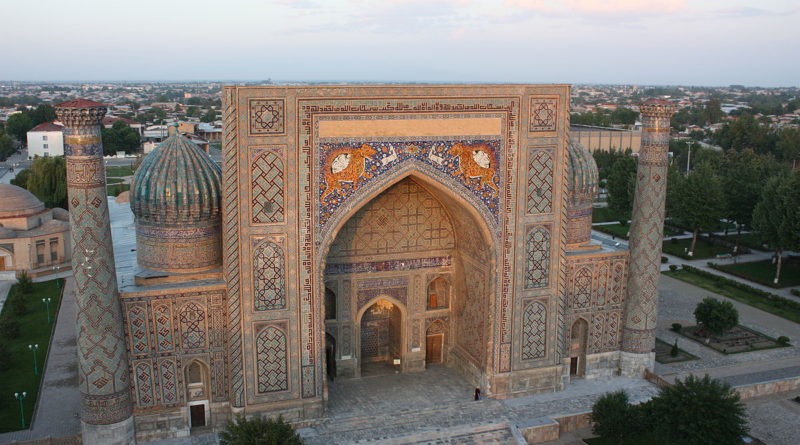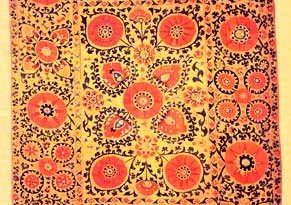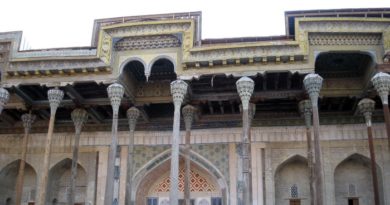Lions in Seclusion. The Temurid Pavilion of the XVI – XVII cc.
Oh, Wind, you are circling the globe during a day,
Fly to the place where I have not been for many years.
Don’t bother in vain those who have forgotten me,
Give my regards to any one who remembers me
Z. Babur
A newborn baby was named in Arab – Zakhir ad-Din Mukhammad, members of his family used the short Uzbek – Babur that is “Tiger”, “Lion”. The founder of the Temurid Empire in India became famous for his construction activity. Gardens, roads, memorial structures, mausoleums and mosques became material signs of this activity. In bright and sometimes sharp history of these monuments, the researchers have lost, and sometimes interpreted in false way, the recondite “architecture of seclusion”, which adds new bright facets to Babur as a great person. In addition, his successors developed this architecture further. This was resulted in transformation of the architectural phenomenon that was known as the Temurid garden and pavilion. Babur had reigned in India just for 5 years – from 1526 to 1530. From the first steps of his short reign, he was searching for a type of the garden and pavilion for seclusion, which could satisfy his taste and correspond with local climate, at the same time considering forms of the Temurid pavilions in Central Asia and structures, which the Indian dynasty of Lodi (1451 – 1526) had constructed before him.
Critical Years (1526 – 1527). Suffering from Indian climate and forefeeling the coming disease, Babur, in 1526 – 1527, constructed buildings differed from previous Temurid architecture. 1526 – 1527 became the critical years when he was constructing a structure for seclusion – “khilvatkhona” in a garden on the left bank of Djamna in Agra. The Indian stepped wells also drew attention of Babur. He constructed them in Agra and to the west of it, in the village of Sikri – for seclusion. In 1527 he destroyed his second, after the sultan Abraham Lodi, enemy, a leader of the Indo-Rajput Confederation, Rana Sangam. Before the battle 44 – year old Babur renounced vine. His daughter, Gulbadanbeghim in her memoirs wrote: “And in the town of Devalpour (Babur) ordered to make a reservoir of 10 sq. gyaz in square from massive stone and told that he would fill up the reservoir of vine. Since before the battle with Rana Sangam he had renounced vine, the reservoir was filled up of lemon juice” (2, 38 – bet). The time for acquaintance with environs, for revising of values and insight concentration had come.
Thirst for Air. In 1528 Babur visited the palace of Man Singh (the XV c.) in Gvalior. “In some sections of the palace there are four floors; two lower ones are very dark. If to sit there for some time, you are starting to see clearer. We were walking with candles. In spite of the rooms are decorated with various Hindustan adornments, they are very fuggy” (3, p. 238 – 239). The architecture of Babur changed the relation to light and especially to air. In Islamic culture, fuggy and clammy air is considered both unsanitary and a form of punishment on Judgment Day. The Koran says in this regard: “Wait the day when heavy smock is falling down from the sky covering humanity: sore punishment” (4). The Uzbek words “to change air (khavo)” mean leaving a city for countryside. The assonant Arabic word “khavala” means “moving to countryside, construction of a private house and responsibility for it”. In India, such rich villas with one or more inner yards were called “khaveli”. The family and descendants of Babur speaking in Old Uzbek changed this word into “khavoli” – “air”. The great grandson of Babur, Jahangir was more amplitudinous in the spelling of this word in his notes about Kabul: “By the evening of that day I went to a small garden around khavali (villa) of Shaih Sikandar, which adjoined the garden of my brother Shah Murad.” (5, p. 427). Intolerance to closeness and thirst for air had enfleshed in Babur’s descendents: “Next to impossible that the emperor Bakhadur Shah (1707 – 1712), for his 5 year reigning, had ever lived in the Red Fort and the most time he had been spending under canopies and hated dreaming indoor”(6, p. 131).
Djal Makhal, Turkhona, Turgokh. In 1526 – 1527, at the edge of his garden Boghi Fotikh (“The Garden of Winner”) on the lakeside in Sikri Babur constructed air red-stoned pavilion on columns, Djal Makhal for rest. The pavilion consists of two octahedral buildings. Inside the octahedron of the outer pavilion, there is an octahedron of the inner pavilion on a high platform – sufa. A courtyard with watercourses, cascades, reservoirs and platforms under the tents separated these pavilions. Each side of the outer pavilion had seven openings and of the inner one – 3. The octahedral room makes a central sector of the inner pavilion. Its flat cupola consists of plates installed in circles on vault ribs. Octahedral layout presents in the third sacred place of Islam – Kubbat as-Sakhra, the Cupola of Rock (690 – 692) in Jerusalem. Octahedral Djal Makhal with single cupola was a symbol of the Temurid leader, his autarchy and monocracy.
In 1527 – 1529 Babur ordered to build Boghi Nilufar – “The Garden of Lotus” on the platform of stone. Unlike the Temurid gardens, it does not have a fence. The constructor of the garden, Ustad Shah Mukhammad had been working for Babur since Kabul period. “At the middle of the lake” – wrote Gulbadanbeghim, -”(Babur) ordered to install the big sufa. When sufa was finished, (Babur) took a boat and went there; he was walking and sitting on that sufa. Having built on this platform the building of Turkhona (the Upper khujra), (Babur) stayed there and wrote the Koran” (2, 41 – bet). Babur’s pavilions were not just air but poetic – he pointed this feature adding to their names the prefix “tur” that means “honorific” -”high” place. Probably, under the influence of Babur, in 1527 his son Kamran Mirzo constructed a pavilion in his garden on the right bank (now the island) of the Ravi River in Lahore. Four sides of the pavilion have five arch openings each. The perimeter gallery plays a role of sun and rain protector. Central 3 – bay section of the pavilion has the second storey well ventilated and saving from summer heat. This storey gave the name to the pavilion – Turgokh (upper mansion). Within two pylons of the pavilion, there are stairs to the flat roof. A tent was installed on its platform – another upper mansion. In 1500 – 1501, waiting Sheibani-khan in the centre of Samarkand, Babur wrote: “On the roof of the madrasah of Ulugbeg Mirzo was installed a tent, and I was staying there” (7, p.104). The stilted center of pavilions became a throne place correspondent to the climate of India – “takht”. The prefix “tur” gives evidence for formation of the type of Babur’s garden pavilions. This point was not understood correctly and got a false interpretation in the world science. In USA, “tur” in Devalpour was translated as “the space framed with law handrails” (8, p.99 (95 – 110), the English scholars, on the map of 1842, called the pavilion in Lahore as “Targah” (Turgur) (9, p.177), after them the Pakistanis called it “Targarh” (10, p. 112 – 113). In this way, from the XIX c. the specific features of the architecture of Babur’s pavilion have been loosing their meaning.
Davlat uiy. In 1534, four years after death of Babur, his son, the dynast padishah Khumayun arranged the wedding ceremony of his younger brother, Mirzo Khindol in octahedral, like Djal Makhal, pavilions, which were also built nearby the river, in this case on the bank of Djamna in Agra. Again, careful Gulbadanbeghim wrote about this event: “On the bank of the river was prepared the place for wedding ceremony; it was called Tilsim (magic). At first was built a large octahedral house; in its middle, a reservoir was dugout and octahedral sufa was installed at the middle of the reservoir. In front of this house, for the wedding of Tilsim. was set a gilt throne. His Majesty padishah and the younger brother had their seats on quilts opposite the throne. Constructed for the magic, this castle was as described further. The wedding was celebrated in the biggest octahedral building. The other small rooms were also . octahedral. In the small building there was a gilt bed, on shelves there were glass scent-bottles and gold and silver sources for vine. Such small shelves were at the sides of. Kiblah.in the east.in the south. and in the north. Above these three buildings, balakhona was constructed. The first khona(premise) – “Davlat uiy”(The House of State). The second khona was called “The House of Happiness”. The third khona was called “The House of Wish”. .Thus, everything was arranged for revel and pleasure. .The boats on the river were also decorated. . Above the boats were seen balakhonas, and gardens were below. There. were flowers. Each eight small octahedral boats formed several octahedrons. The God granted his blessed soul such inventions, which impressed each person saw them and amused. .The other children of my father-padishah, unfortunately, were not honoured with such wedding ceremony” (12, p.50 – 54).
So, the pavilions on the land and even boats at that extraordinary wedding were octahedral and had the second storey – balakhona that is light superstructure. Sacred octahedral form and balakhona meeting the climate conditions were getting the architectural canon. Probably, the miniature artists created the wonderful scenario of the wedding. Such 2 – storey (pavilion) with balakhona on its roof and with gilt, Gulbadanbeghim described, throne was exposed as the interior for Zuleikha tempting handsome Yusuf. 125 years earlier this wedding, in Balkh besieged by Shahruh, a son of Temur, the classic of Uzbek literature Durbeg wrote his dastan “Yusuf and Zuleikha” in the Old Uzbek. Troubles and trials of the young padishah, outcast by his brothers from the homeland, reminded the fortune of Babur. Obviously, the family of Babur knew this popular dastan and had got its copy with miniatures exposing idealized 2-storey pavilions with balakhona. In any case, at that wedding it was the first experience in the construction of such pavilion. Soon it was developed in the next architectural masterpieces.
Sher Mandal. In 1540, the commander Sher Shah (Sher – “Lion”), a member of the Afghan dynasty Sur (1540-1555) deposed Khamayun and took power, and in 1542 he ordered the construction of Sher Mandal pavilion in Delhi for solitary life. Sher Shah Sur had seen Djal Makhal of Babur and Davlat uiy of Khamayun. He was highborn, his ancestors were at court of the Lodi dynasty and he served for Babur and, therefore, – could visit his gardens and pavilions. Function and octahedral form of his Sher Mandal was akin to Djal Makhal.
Sher Mandal differed from Djal Makhal, open before all winds, by manly harmony of blind arcades. As for its two floors and balakhona on the flat roof, it is a copy of pavilions in miniatures and of Davlat uiy of Khamayun. The pavilion of Sher Shah is decorated with lancet arches and has fine proportions. Probably, its builder was the same artist-architect who designed Khumayun’s pavilions. Sher Shah died in 1545. Ten years later Khumayun turned back to the Delhi’s throne from his Iranian exile. In 1556, spending his time in intellectual exercises in Sher Mandal, once when he was hurrying to the mosque nearby to be in time at the pray, he fell down the stair and soon died. The mausoleum of Sher Shah in Sasaram developed compositions of Delhi’s mausoleum of two commanders from Central Asia, one of Giyasuddin Tuglak (1325) of the Turkic origin and another of Sikandar Lodi (1518), from Afghanistan. A stone bridge of 225 m in length links the cuboid mausoleum of Giyasuddin located in the natural lake with its beach, and octahedral mausoleum of Lodi is located in the square yard-garden. The octahedral mausoleum of Sher Shah is also located in a square yard and in the middle of the reservoir of 420×420 m. The bridge of 172 m in length links the mausoleum with the yard. “The diameter of the mausoleum of Sher Shah (the width – 75 m, the height – 45 m) is much more a diameter of any mausoleum of Lodi”. Before Sher Shah only the mausoleum of Babur, Djal Makhal had such width. Sher Shah was a man of exclusive courage and self-exaltation and wanted to excel his forgoes in order to, as his court historian wrote, “my name will be respecting in the world up to the Day of Resurrection” (11, p. 87).
Davlatkhona. Jahangir, in his own turn, combined the compositions of Sher Mandal and the mausoleum of Sher Shah. The emperor was bad with asthma and his portable pavilions had been installing in the water reservoirs. In 1620 in his hunting areas nearby Lahore, he ordered to install a pavilion in the middle of the reservoir of 269×226 m and with a bridge of 92 m in length. Jahangir, like Babur, extremely needed the air. That’s why the second storey, unlike Sher Mandal, has three openings at each side – as it was done at Djal Makhal of Babur. The openings in the first storey were rectangular, like at pavilions in miniatures. There were arches and rectangular panels, Jahangir liked most of all. Balakhona on the flat roof crowned the pavilion. In 1643 Shahdjakhan reconstructed this pavilion. The Pakistan scholar A. Rehman has fixed the correct historical name of the pavilion – Davlatkhona. So, features of Babur’s Djal Makhal and Khamayun’s Davlat uiy converted to the architecture and name of Jahangir’s and Shahdjakhan’s pavilion of Davlatkhona. Such classically rich pavilion has never been reproduced again but the similar general layout of the pavilion and garden became standard later, at the time of Shahdjakhan. In 1631 – 1632 he ordered to install a bridge to the square ground at the middle of a round reservoir in the yard of Shish Makhal at the Lahore citadel.
Later two gardens with walls around in Fotihgarh nearby Lahore (the second considered to belong to Dara Shikoh, a son of Shahdjakhan) had been planned with a single path to the center of the garden where, in the first case, was 1-storey pavilion within a square reservoir and, in the second case, two square structures nearby the octahedral reservoir. The sizes are less than in Sasaram but close to the reservoir of Jahangir: the first garden – 242×201 m in square with an alley of 80 m in length and the second one – 270×270 m in square and an alley of 90 m in length. So the architecture of Babur’s pavilion for seclusion had formed a phenomenon, which changed the layout of the classic Temurid garden “chor-bog” with a wall around and typical four parts the area was divided.
Classic of Babur. Escaping from military and interindividual conflicts in garden pavilions, Babur had been revising his prior values: “May be, it’s better now to have a small begstvo against a promise of both kingdoms” (1, p.99). Psychological crisis is obvious: “More often I want to talk with the people but how to begin – I don’t know, understand me” (1, p.80). “The one living far from the people can escape disasters” (1, p.23).
“I feel achy, and the way is long,
The life is short, and the road leads far,
Show me, to the strayed, the way,
Which would lead me to the aim”
The Indians from outside his gardens saw the transformation of Babur as a person: they called him “kalandar” – “dervish”, “anchoret”, “hermit” (13, p.10). The Temurid paradise garden and pavilion for seclusion symbolized the own territory Babur wanted and his ability to govern. The garden accepted Babur escaping from military camping and just active life. “Like padishah I have had enough of sultanate,- it would be better for me to stay at the Zarafshan garden, and to give the padishah’s power to Khumayun”, – Gulbadanbeghim reproduced with a sorry (2, p.42). That garden has been lost. However, the similar pavilion at another Babur’s garden can give some notions of that pavilion at the corner of the garden. This garden of Gulafshon, called Rum Bugh is located to the north on the river course of Djamna in Agra. In its southwestern corner there is a triangular structure with a flat roof where a single cupola on columns is. The Indian masons call such cupola “chatri”. But now, after Davlat uiy, Sher Mandal and Davlatkhona, we know that true name of such cupola is “balakhona”. The Indian structure was adapted for the Central Asian function. The area of the garden and pavilion had served the life, creative work, pleasure and, finally, the death. Babur died on December 26, 1530 at the age of 47. According to his will, he was buried at the Chor Burdj pavilion in the garden of Zarafshan in 1530 and had been there until 1539 when the body was transported to Kabul where, before the Indian period, he had been reigning for 26 years.
Deeply individual aspects of the architecture of Babur’s pavilions, we specified above, reveal his active role in the development of Central Asian Temurids’ architecture and in formation of new architecture in India. However, this point had not found correct understanding for the XX c. At the middle of the XX c., the Indian scholars came to the idea: “Babur depended too much on imported ideas and inspiration, and that’s why his initiatives in architecture were put aside”. At the end of the XX c. Babur was countered with his heirs: “Elements of the Temurid architectural style were introduced in India not by this, the most conscious Temurid, but more probably by his successors, Khumayun, Akbar and Shahdjakhan”. Such falsifications prove the absence of general and deep approach to Babur’s heritage, and must be considered a serious danger for social and scientific concepts, first, in the field of architecture. The architectural heritage of Babur’s short reigning in India had been developed and enriched thanks to deference of his heirs to it. They considered his biography “Babirnomah” as a life guide. Khumayun had been saving this manuscript for his hard years of exile in Iran. A grandson of Babur, the emperor Akbar ordered to translate “Bobirnomah” from Old Uzbek into Farsi. He highly appreciated this work and called it “The Memoirs of Babur, World Winner; the Code for Practical Mind”.
The evolution of just one type of Baburs’ pavilions, traced in this article, actually proves careful relation of Babur’s children and grandchildren to him. Thanks to them, the architecture of Babur became exemplary and classic. Now, when the architecture of Uzbekistan more often and a bit schematically styles the Temurid pavilions, the unknown tradition of the XVI – XVII cc., analyzed above, is revealing deeply human and, therefore, vital sources of this classic.
Author: Shukur Askarov




